During their free time the participants profited from the outdoor
installations such as a petanque place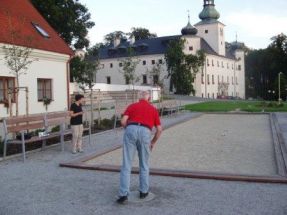
Playing
"Petanque"
Ninety-three regular students coming from twenty-six different countries
attended the fifteen School in the new series of the European School of
High-energy Physics, which took place in Třešť, from 19 August to 1 September
2007.
In addition, there were 15 Czech listeners. Seven attended the regular
discussion sessions and eight attended a special session led by a Czech student
who participated in the 2006 School in Sweden.
The School was co-chaired by Rupert Leitner, Charles University and Jiří
Hosek, Academy of Sciences of the Czech Republic who both did a great job as
local Directors.
Most of the students took advantage of the transportation organized by the School from Prague to Třešť and back the last day.
The School was hosted in Zamecky Hotel
in Třešť (also known as Třešť Castle) a Chateau Hotel ranked among the
most popular tourist resorts in the Vysočina Region.
Třešť is situated
between Prague and Vienna in a calm environment surrounded by the hills of the
Czech-Moravian Heights. Třešť is the birthplace of J.A. Schumpeter, one of the most
influential 20th century economists, the first Austrian Minister of Finance and
the father of the Japanese post-war economic miracle,
Šimon Partlic, an exceptional Renaissance astronomer and mathematician, František Radkovsky, the first Pilsen
diocesan bishop, and actor Otto Šimánek. The bronze
bust of Franz Kafka reminds visitors of the writer’s frequent stays in
the town during the years 1900 - 1907.
Hotel Zamecky, (Zamek in Czech means Castle) is a Renaissance Castle built in
the 16th century that together with the adjoining park (15 ha) became
the property of the Academy of Science of the Czech Republic in 1984. After ten
years of intensive restoration works, the castle was transformed into a
conference centre in 1994.
It was entirely reserved for the participants in
the School. According to the tradition of the School, the students were sharing
twin rooms, mixing nationalities and in particular Eastern students with Western
ones.
The lectures were held in a conference room located on the first floor.
Tea, coffee and cookies were served in a nice area just in front of the
restaurant, and smaller rooms were used for the discussion sessions.
Tatyana
and Danielle were omnipresent in the School Secretariat located next to the
lecture room. They are very grateful to Zdenka Broklova from Charles University
for her efficient and kind support. During the whole School Zdenka not
only was a great help to the Organizers but also assisted the Students in
particular acting as the go-between each time a “logistic” or “linguistic”
problem appeared.
During their free time the participants profited from the outdoor
installations such as a petanque place
Playing
"Petanque"
It was also possible to hire bicycles and there were many possibilities for
nice walks in the park, along the river, by the lake or in the forest
surrounding the hotel. The students soon discovered a nice small beach
where they liked to gather and have sportive swims in the lake. Not to
forget the billiards, the bowling, the bars and the disco in town.
Excursions and Special Events were organized during the
school.
On the first Monday, Professor Rostislav Mach, Academy of
Sciences of the Czech Republic and Egil Lillestol, Director of the CERN Schools
of Physics, greeted the participants with short speeches during a welcome drink
that was served just before dinner.
The dinner was followed by a beautiful
Concert of chamber music performed by “The Martinů
Quartet”: with Lubomír HAVLÁK - 1st Violin, Irena HERAJNOVÁ - 2st Violin, Jan
JÍŠA - Viola and Jitka VLAŠÁNKOVÁ, Cello.
The Martinů Quartet has given
concerts in most European countries, in the States, Canada Japan and Cuba. It
has performed many famous international festivals and venues. It broadcasts
regularly on the Czech Radio and Television and has made numerous recordings.
The Quartet’s repertoire includes works from the mainstream of the string
quartet literature. Naturally, it specialises in the works of Czech composers
and the selection for this concert was the String Quartet in A Flat Major, Op.
105 fro A. Dvorak and the String Quartet No 2 “Intimate Letters” (1928) by L.
Janacek. It was very interesting to hear about the circumstances that led
L. Janacek to write this piece of music dedicated to a young woman with whom he
fell in love.
The four musicians received big and long applauses from the
delighted audience that was, a lot younger than their usual public.
The first Wednesday afternoon was a visit to Jaroměřice
and Šatov.
The extensive Jaroměřice Baroque chateau complex with the parish
church of St. Markéta is surrounded by a French garden and an English park. The
stylish equipped interiors with a valuable collection of musical instruments and
porcelain remind one of the period connected with the personalities of Jan Adam
of Questenberk and F. V. Míča, when the chateau was the centre of cultural life
with its own theatre and orchestra.
There was a guided tour of the Castle and
also some free time in the gardens.
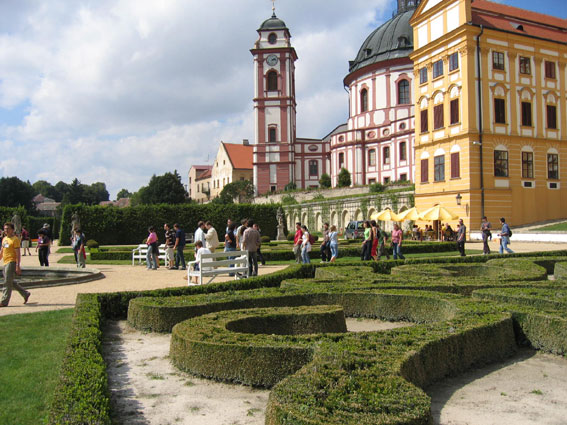
Jaroměřice: the Baroque chateau
Šatov:
The
town of Šatov lies just before the Austrian border. The town and its surrounding
vineyards have long produced some of the country's finest Moravian wines. The
excellent soil conditions and Continental climate make it perfectly suited for
grapes.
The participants were split in two groups visiting one after the
other the “Painted Cellar” most likely carved out in the late 19th century but
that took on its current form when a one-armed man named Max Appeltauer took to
the tunnels and began his work there in 1934. Not an artist by trade, Appeltauer
set to carving and then painting into the sandstone walls an eclectic set of
scenes portraying everything from Prague Castle to Snow White and the Seven
Dwarfs, as well as the Šatov coat of arms.

The
Painted Cellar in Šatov
All his work was dedicated to a 15 years old girl, we was in love
with.
Inscription in the dark cellar: VÍNO, ZENY A ZPEV,
ZAHLADÍ VESKERÝ HNEV ("Wine, women, and song will remove all anger")
indicates that the cellar was at one time a popular place, where people gathered
after Mass, girlfriends and all. Wives searching for their husbands would often
enter, sending girlfriends scurrying into the subcellar.
Then, in another large wine cellar the participants visited long tunnels leading to small rooms where one can rent a private storage box. The wine bottles are locked in a barred storage space where wines mature in ideal temperature conditions. The participants were invited to a generous wine tasting (different white and red wines). The “Yes” wine, a Traminer, was the most popular!
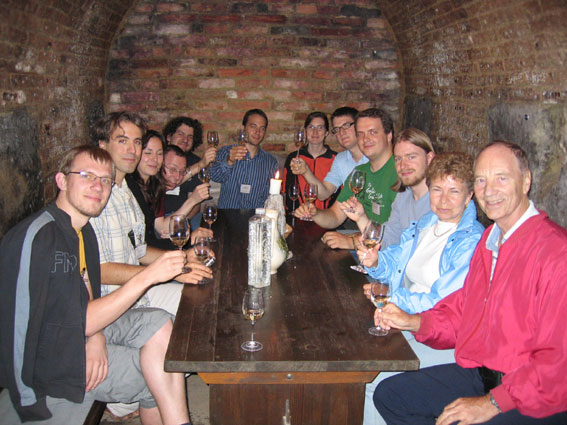
Wine
testing in Šatov
A buffet dinner was served in a former barn. The food was excellent and wine was served without limit. A group of folk musicians stood on a wooden stage, playing traditional instruments in particular cymbalo.
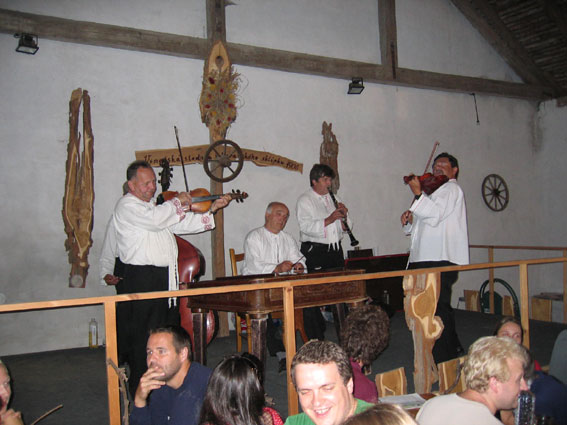
Folk
musicians
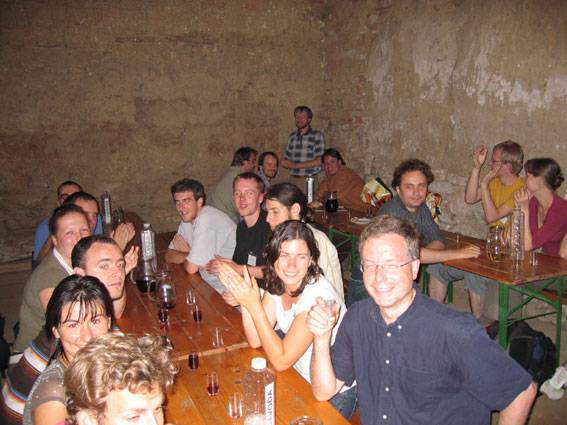
Dinner in Šatov
On the way back to Třešť it was clear that the wine tasting had also been a
test for some students to determine their tolerance limit to alcohol…
POSTER SESSION
On Thursday the students displayed their work in the form
of posters at a special evening session. The posters, of very high quality
both technically and in content, were put up on display panels in the Music Room
where they stayed on display for the remaining part of the school.
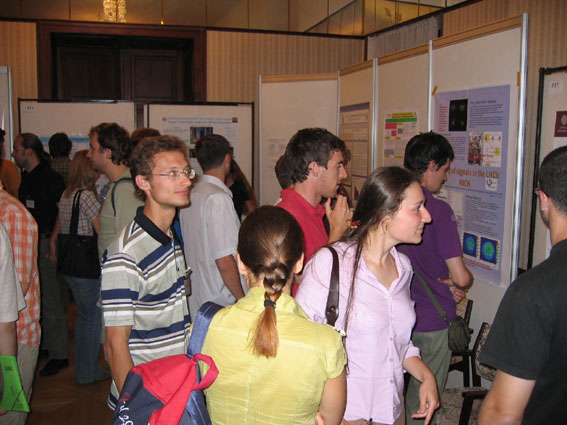
Poster Session
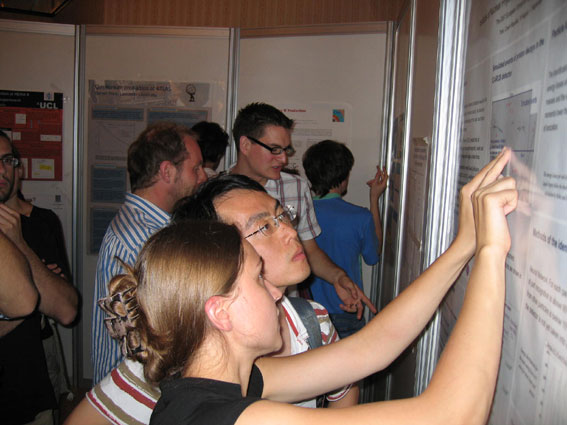
Discussing the results
During the Poster Session a pronunciation competition was organized by Ronald
and a price was given to the participants who pronounced Třešť with the most
appropriate accent.
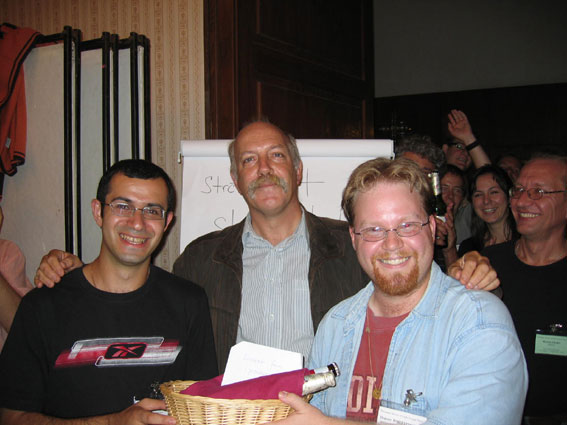
Winners of the pronunciation competition
* Třešťsky´ potok,
strč prst skrz krk*
A full day excursion was organized to Prague on Saturday, 25 August.
The
participants were split into four groups each with an official guide, and the
tour went across Pohorelec (famous antiques), Strahov Monastry (founded in 1140
– famous library), Cernin Palace (one of the most important Baroque buildings in
Prague) and Loreta (pilgrimage site) and the Prague Castle.
At the Prague Castle we came across a ceremony with distribution of awards that was accompanied by an famous orchestra, the Prague Garrison band. For a while we listened at Latino rhythms and looked at the local drum majorette dressed a white costume.
We arrived at
Karolinum in Center town. The Charles University in Prague (Universitas Carolina
Pragensis), is the oldest and largest Czech university and among the oldest
universities in Europe (established in 1347-48). We were served
refreshments.
Then, Ivan Wilhelm, former Rector of the Charles University
told us about the place in the large lecture room still in use for special
ceremonies.
A small group was guided by Jiří Langer, on a tour named ¨Prague
and Physics¨. The book entitled “Prague and Physics”, edited by
Jiří Janta
and Jiří Niederle, presenting some of the names of the physicists whose lives
and work are associated with Prague, was offered to each participant upon
arrival in Trest. .
After some free time in town we all reconvened at the Mayor’s Residence. The Vice-Mayor welcomed the participants in the School as well as some other distinguished guests, in particular Prof. Hampl, rector of Charles University and Prof. Musilek, vice-rector of Czech Technical University.
We were served a delicious and abundant buffet
dinner accompanied by Champagne and good wine.
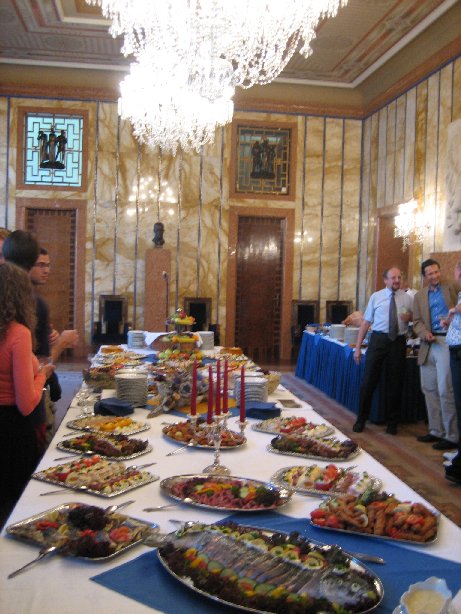
Buffet at the Mayor's Residence
The Mayor’s Residence constructed in 1925-1928 is beautiful building with a
neo-classical façade. The apartments were designed by the architect Frantisek
Roith who also executed the ceiling paintings and designed the carpets,
tapestries, and furniture and textile wall hangings in the late Art Nouveau
style.
On Monday 27 August there was an after dinner lecture, “From the Peas of
Gregor Mendel to the Human Genome” by Professor Václav Pačes, President of the
Academy of Sciences of the Czech Republic. Professor Pačes is engaged in
genomics. His research group was one of the first to completely sequence a
genome, namely DNA of a bacterial virus. The audience was extremely interested
by his comments about “ the comparative genomics of certain regions of the
human genome and the genome of our closest cousin, the chimpanzee. We have most
of the genes identical, or very similar with identical functions. And the
question is: where is the information that makes us humans and that makes
chimpanzees apes?”.
Numerous questions followed his lecture showing how
much the thin border between bacteria, animals and men puzzles us.
On Wednesday, 29 August was a visit to Telč, a UNESCO World Heritage
Site since 1992.
Telč is a medieval planned town, preserving its original
layout and the castle-settlement relationship very clearly. The quality of its
architecture is high, particularly the Renaissance market place and chateau. The
triangular market place possesses great beauty and harmony as well as great
cultural importance, surrounded as it is by intact and well-preserved
Renaissance buildings with a dazzling variety of facades. There was a guided
tour of the Telč
Castle.
The castle is a big Renaissance masterpiece (originally Gothic,
reconstructed in High Gothic style). Several remarkable rooms have stucco,
fresco and graffiti decoration and beautiful wooden panel ceilings with
impressive figurative wooden carvings. The tour leads also through the flat of
the last castle owners, the Podstatsky-Lichtensteins. Its furnishings, mostly in
their original conditions, represent a significant testimony of the appearance
of noble interiors. Among some very interesting exhibits special attention
should be paid to the collection of historical faiences and many African hunting
trophies.
Visit of
Třebíč:
This
town also became a UNESCO World Heritage in 2003 (because of the ensemble of the
Jewish Quarter, the old Jewish cemetery and the Basilica of St Procopius that
are reminders of the co-existence of Jewish and Christian cultures from the
Middle Ages to the 20th century). But the participants found the venue
disappointing. We would have liked a guided tour, and Telč, which we had
just left, was definitively much more pretty.
On the way back to Třešť we
stopped at a Brewery in
Jihlava.
There was a guided tour and a beer tasting. An abundant dinner was served in
the nearby restaurant being part of the Jihlava brewery Ježek. All the visitors
were offered a set of four small bottles of beer as well as a nice large glass
that can hold half a litre of beer!
The traditional Farewell Banquet was organized on the last evening. Invited guests were, Professor Jirˇí Niederle, Academy of Sciences of the Czech Republic, Dr. Alexei Sissakian, Director General of JINR, Dr. Jos Engelen, CERN Chief Scientific Officer, Professor Zacek and Prof. Stuchlik, rector and vice-rector of Silesian University, Opava.
After dinner Nick Ellis (who took over the School since Egil had
to go back to Norway) invited all the participants to join the conference room
where a party was set up.
Professor Niederle (ASCR) gave a short speech
expressing thanks to the Organizers and the participants for the successful
School.
Nick gave a short farewell talk expressing special thanks to the
local Organizers and their team, to the staff in the hotel who had helped in
making the two weeks so pleasant. Mrs. Lechnyrova, the Hotel Manager, highly
deserved a big applause and received a very nice book offered by
JINR.
Anecdotes collected during the two weeks of the School were turned into
reasons to congratulate some "deserving" students, and small prizes were offered
by JINR and CERN.
After this "official" part it was time for the great master
of ceremony, Denver Whittington, elected by the students to present the
“students’ show”.
Students continued their performances with sketches and
songs accompanied by good wine and beer.
We enjoyed the “Beauty contest” sketch performed by Zdenko van Kesteren (the
nerd), Rossella Romita (the Bimbo), and Jan Kaspar (the drag queen) and
competing for the Miss Charm, Miss Strange and Miss Summer School 2007
titles.
5 questions/performance:
- Mime your favorite Feynman
diagram
Ils ont fait un qq->e+e-
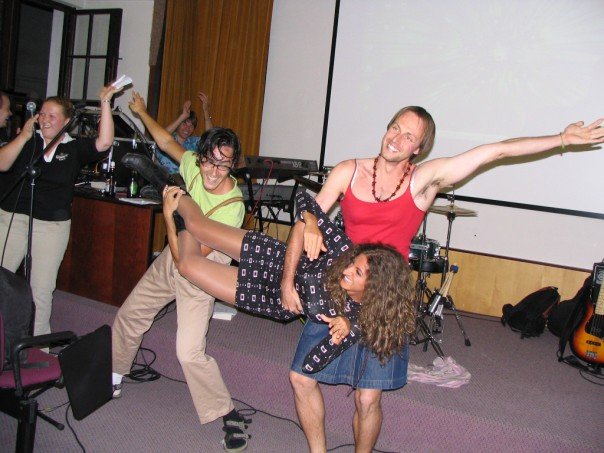
Feynman Diagram
- Best shot dance (30 secs on Vogue from Madonna)
Une image vaut
mille mots
- What is your best quality?
Zdenko: "I can code faster
than the speed of light! But my code gets contracted and it takes forever to
compile"
Rossella: "Can I name two? (pointing at her breasts)"
Jan: "I'm
humble and modest"
- What is your favorite physics topic?
Zdenko:
"Heavy Ions"
Rossella: "I want strong interactions..."
Jan: "I like
exotics!"
- What would you do to make the world a better
place?
Zdenko: "I want all forces to unify... in peace"
Rossella:
"Lots of partners for everyone!"
Jan: "Lots of superpartners for
everyone!!"
Below are the lyrics of the song: "Wonderful School".
(Mike
Flowerdew, Frederik Ruehr, Janet Dietrich, Andrée Robichaud-Veronneau, Zdenko
van Kesteren and Emmanuel Turlay, playing guitar)
Don't know much about
SU(3)
Don't know much supersymmetry
Don't know much about cosmic
rays
Don't know much about B decays But I know we all need QFT
And if we
could include gravity
What a wonderful world this would be
Don't much
about Heavy Ions
Don't know how the strong coupling runs
Don't know how a
Monte Carlo works
Don't know much about exotic quarks
But I know neutrinos
do have mass
And if I listened in discussion class
What a wonderful world
this would be
Now I don't claim to be an A student
But I'm tryin' to
be
Oh maybe by being an A student baby
I could break gauge symmetry
I
can't calculate most basic trees
Don't know much about GUTs
I lost track
around Newton's law
Don't know what the Green's functions for
But I know
I've had enough of ham
And if we didn't start at 9 am
What a wonderful
world this would be
(guitar solo)
But I know I've had enough of ham
And
if we didn't start at 9 am
What a wonderful school this would
be
(Apologies to Sam Cooke)
(special thanks to Andrée who sent the
lyrics).
The “12 days of Summer School” performed by Rob Lambert, Colin McLean
and Emmanuel Turlay, with help from Catherine Wright, Annefleur Barfuss,
Nick Austin and Nick Styles was excellent.
To give you the run down from the
top:
On the 12th day of summer school the lecturer taught me:
12 fermion
fields
11 sub detectors
10 to the 20
9 -teen free constants
8
gluons gluing
7 TeV colliding
6 types of quarks
5 Golden Modes
3+1
Dimensions
3 Generations
SU(2) Left
and a quark loop in a strong
tree
And for the reprise:
On the last day of summer school a theorist
told me:
12 Susy partners
11 Dimensions
10 to the 20
9 -new free
constants
E8
7 neutrino questions
6 real scalars
SU(5)
4
Generations
3 sigma searches
SU(2) Right
But experiment will never
agree
(special thanks to Rob who sent the lyrics).
Not to forget the movie* directed by Seth Zenz and Cyril Topfel "Swinging'n Singing" where it's raining men!
Also the “staff” contributed to the show, Helmut Eberl playing his bagpipe
(with a special dedication of one piece to Egil who was missing the evening) and
the performance culminated by John Swain commenting on a slide show with random
physics problems.
Rock Concert
LINKS to the official photograph and the corresponding names.
LINKS to some of the student’s photos:
Erik Adli:
http://www.pvv.org/~erikad/Themepages/Travel/Trest/Trest.html
Dmitri
Shtol
http://wwwsnd.inp.nsk.su/~shtol/photos/Czechia/
Cyril
Topfel
http://www.elementary-particles.net/trest.html
Andrée
Robichaud-Veronneau
http://home.student.uu.se/elco7347/FirstDay.MOV
http://home.student.uu.se/elco7347/Karaoke.MOV
Florent Robinet
http://florent.robinet.free.fr/Index_photo/CERNschool.html
THANKS
We are sure that all the students join us in thanking the
lecturers and discussion leaders for their inspiring lectures and
discussions.
The local organizers of the school deserve a big thanks for the fantastic job that they did during the last two weeks. We would also like to thank Milos Lokajicek, Jan Svec and Lukas Fiala in particular for their computing support, Jaroslav Cvach who organized the trips, Jirˇí Dolejsi especially for the arrangements of the visit to the Prague Mayor's Residence, Milos Pachr, Vojtech Petracek and their team of students, responsibles of sports and other activities and Eva Uhrova who coordinated the excursions and the transportation.
Numerous mails received by
the students reflected that they are grateful to the Organizers for having set
up an outstanding scientific programme with top-level lecturers as well as a
nice and interesting social programme.